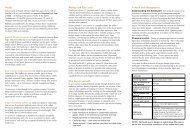Bushland Weeds Manual - Environmental Weeds Action Network
Bushland Weeds Manual - Environmental Weeds Action Network
Bushland Weeds Manual - Environmental Weeds Action Network
Create successful ePaper yourself
Turn your PDF publications into a flip-book with our unique Google optimized e-Paper software.
14<br />
Chapter 3 Grass <strong>Weeds</strong><br />
• Transition occurs when the growing points stop<br />
producing vegetative material and start developing<br />
flowers and the tissue between nodes, the<br />
internode, elongates. Because of internode<br />
elongation, slashing or mowing at this stage can<br />
remove many axillary buds, thereby reducing leaf<br />
production in the regrowth.<br />
• Flowering begins when the seed head is just<br />
emerging from the leaf sheath (boot stage) and<br />
continues through to seeding. Some grass-selective<br />
herbicides are only effective if applied prior to the<br />
boot stage. Slashing or mowing during flowering<br />
may facilitate the spread of seed.<br />
The period of active growth depends largely on<br />
whether the plant is a cool season (C3) or warm<br />
season (C4) grass. Cool season and warm season<br />
grasses differ in the way they use carbon dioxide. Cool<br />
season grasses (Wild Oat, Blowfly Grass, Perennial<br />
Veldgrass) photosynthesise more effectively, and thus<br />
are most actively growing, during the cooler periods of<br />
winter and spring (15-25° C). Warm season grasses, or<br />
summer grasses, photosynthesise best with full light<br />
saturation and consequently their period of most<br />
active growth is late spring and summer (25-40° C).<br />
The summer growing Couch (Cynodon dactylon),<br />
Kikuyu and Lovegrass are all C4 grasses.<br />
For successful herbicide uptake grasses should be<br />
sprayed in the season appropriate to their<br />
photosynthetic pathway and when actively growing.<br />
Fire and the spread of grass weeds<br />
Many grasses, especially caespitose species, have long,<br />
narrow, vertical leaves that are efficient in strong light<br />
allowing sunlight to penetrate deep inside the clump<br />
(Gibbs Russell et al. 1991). This structure allows the<br />
production of a large biomass in a small space. Stems<br />
die each year and new ones develop. Over time a large<br />
biomass, much of it dead material, creates a significant<br />
fire hazard. As a result, grass weed invasions can lead<br />
to changes in fire frequency and intensity.<br />
These changes are self-perpetuating as the disturbance<br />
caused by fire tends to promote germination and<br />
establishment of seedling grasses (Cheplick 1998,<br />
Williams and Baruch 2000). At Shenton <strong>Bushland</strong>,<br />
Perth, Perennial Veldgrass was mapped in the year<br />
following an intense fire that burnt half of the site. A<br />
comparison between a pre-fire bushland condition map<br />
and the post-fire Veldgrass map, highlighted a<br />
significant post-fire expansion in the population.<br />
Previously healthy bushland now recorded 75-100 %<br />
cover of Veldgrass (Brown and Marshall<br />
unpublished data).<br />
Fire contributes greatly to grass invasion in lownutrient<br />
soils, where post-fire increases in nutrients,<br />
light and space availability are more effectively<br />
exploited by invasive grasses than by the native flora.<br />
It is important to reduce the possibility of fire in<br />
bushland areas at risk of grass invasion. Where<br />
bushfire does occur target resprouting plants and<br />
seedlings for control before they become<br />
established.<br />
Management and control<br />
Prevention and early intervention<br />
Degradation of our native bushland remnants through<br />
clearing, fire, disease and mismanagement may be of<br />
particular relevance to the establishment and spread<br />
of grass weeds. Often an observed decline in the<br />
canopy cover within Banksia woodlands around Perth<br />
correlates with an increase in the occurrence of<br />
Perennial Veldgrass. Reduction in canopy cover leads<br />
to an increase in light availability, a condition favoured<br />
by many grass weeds (Williams and Baruch 2000,<br />
D’Antonio et al. 2001).<br />
Weed grass invasion can be limited by:<br />
• Maintaining the bushland canopy. Many grasses<br />
prefer open sunny sites and do not establish or<br />
compete successfully in the shade.<br />
• Reducing the potential for bushfires. As<br />
mentioned, fire can significantly increase the<br />
establishment and spread of grass weeds.<br />
• Identifying unfamiliar grasses. It is important to<br />
determine if grasses are introduced or native.<br />
Early identification of grass weeds allows you to<br />
assess the likelihood of invasion and prevents<br />
mistaken eradication of native grasses!<br />
• Establishing weed barriers.<br />
Weed barriers<br />
A common grass weed problem in urban remnants is<br />
the spread of Kikuyu, Couch or Buffalo Grass<br />
(Stenotaphrum secundatum) from adjacent parks and<br />
road verges. A successful ‘weed break’ can be created<br />
by embedding a physical barrier such as weed mesh or<br />
conveyor belt vertically into the ground and using<br />
concrete kerbing above it. This prevents rhizomes<br />
creeping into the bushland and provides a mowing<br />
edge for council mowers (Box 3.4). Some grasses have<br />
rhizomes 50 to 60 centimetres below ground and any<br />
root barrier must allow for this.<br />
The bush itself often provides an excellent weed break<br />
(Box 3.2). However, the sandy soils and open<br />
vegetation of Banksia woodland or the friable soils of<br />
York Gum–Jam woodlands are more susceptible.<br />
Establishing a dense cover of locally-occurring low,<br />
medium and tall shrubs along the edges of degraded<br />
sites and paddocks could act as a sieve, preventing<br />
entry of wind and water carried seed. Knowing the<br />
prevailing wind direction, position in the landscape<br />
and relationship to waterflow can help to determine if<br />
the adjacent paddock, weedy rail reserve or over-run,<br />
semi-rural backyard, is the weed source. When planting<br />
or direct seeding, use native seed collected from the<br />
area of bushland you are protecting and only plant<br />
where run-off or prevailing winds are definitely<br />
carrying weed seed in.



